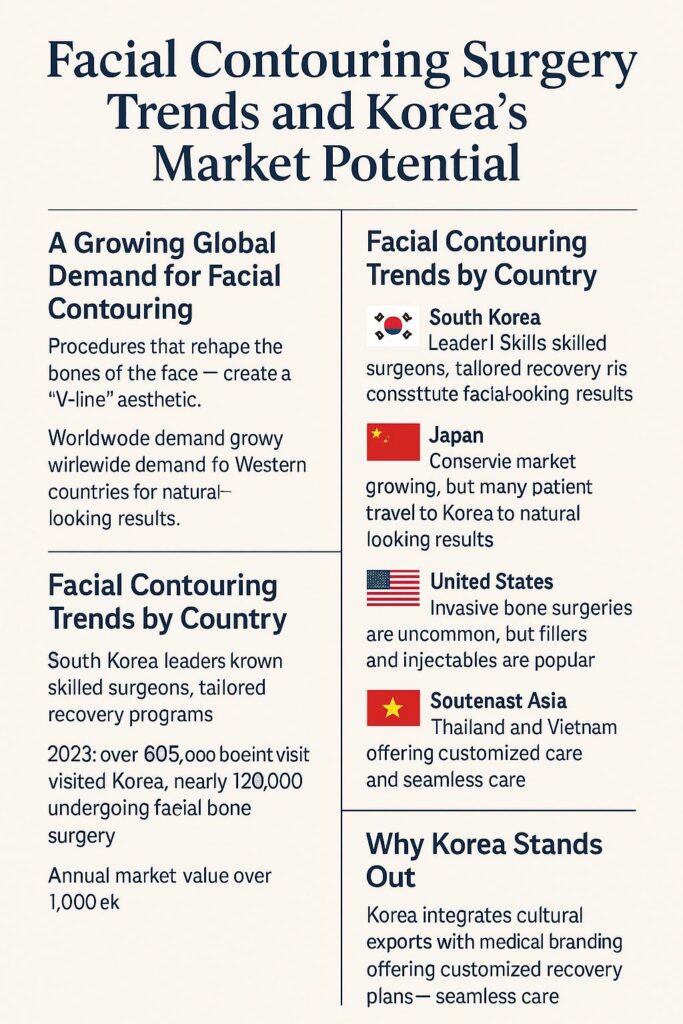
Global Trends in Facial Contouring Surgery and Korea’s Market Potential
Facial contouring surgery has become one of the fastest-growing procedures in global aesthetic medicine. Once limited to a few specialized clinics, it now draws international attention thanks to changing beauty standards and the rise of medical tourism. Among the countries offering these surgeries, South Korea has built a reputation for surgical excellence, comprehensive patient services, and innovative technologies.
A Growing Global Demand for Facial Contouring
Facial contouring (“안면윤곽”) refers to procedures that reshape the bones of the face, including cheekbone reduction, jawline slimming, and chin surgery. These procedures create a more harmonious and refined facial structure, often aligning with the “V-line” aesthetic popular across Asia.
Demand continues to grow worldwide. In East Asia, facial proportions are a key element of beauty. In Western countries, while bone surgery is less common, non-invasive facial reshaping has gained popularity. As people become more aware of facial balance and symmetry, the appeal of long-lasting, structural changes has expanded beyond regional markets.
Facial Contouring Trends by Country
South Korea leads the global market. Patients choose Korea for its skilled surgeons, advanced equipment, and tailored recovery programs. Clinics commonly offer services in multiple languages and assist with accommodation, transportation, and aftercare.
China has a growing domestic market, but many patients still prefer traveling to Korea for surgery. Korean clinics provide more natural-looking results, and many Chinese celebrities openly endorse them.
Japan remains more conservative. While facial contouring is available, Japanese patients often choose subtle enhancements or non-surgical procedures. Cultural preferences lean toward natural aging and minimal changes.
The United States shows interest in facial shaping, but invasive bone surgeries are less common. Fillers and contouring through injectables are more widespread. However, a niche group of patients especially among certain communities and influencers seek Korean-style surgical contouring.
Southeast Asia, particularly Thailand and Vietnam, is becoming a strong market. Clinics in these countries focus on affordability while adopting techniques from Korean surgery. Some even train under Korean specialists or import equipment directly from Korea.
Inside Korea’s Facial Contouring Market
The Korean facial contouring market is built on precision and patient trust. Surgeons undergo rigorous training, often including fellowships abroad or international presentations. They use 3D CT scans, AI-based facial analysis, and robotic systems to improve accuracy and safety.
In 2023, over 605,000 foreign patients visited Korea for medical services. Nearly 120,000 of them underwent facial bone surgery, contributing to a market worth over 1,000억 원 annually. Average surgery costs range from 6,000,000 to 20,000,000 KRW per case. Clinics generate high margins, especially through bundled services including skincare, accommodation, and concierge support.
Why Korea Stands Out
Korea’s advantage is not just technical but, it’s strategic. The country integrates its cultural exports with medical branding. The popularity of K-pop and K-dramas has normalized the pursuit of aesthetic procedures, with many patients aiming for similar facial structures seen on screen.
Clinics also offer seamless care. Patients receive customized recovery plans, including facial massages, dietary support, and progress tracking. Many clinics go beyond surgery by offering digital consultations, psychological counseling, and aesthetic coaching.
The legal system supports patient protection. Clinics must meet strict standards for consent, documentation, and safety. This reassures foreign patients and enhances Korea’s global trust.
Market Outlook and Business Value
The facial contouring industry in Korea is expected to grow by 6–8% annually. Male patients now make up a larger share, and many seek professional advantages through cosmetic surgery. New developments like regenerative medicine, AI planning tools, and remote consultations.
Some clinics are exploring overseas expansion through franchising or brand licensing. Others develop apps for virtual facial design or postoperative tracking. These moves turn the traditional clinic model into a digital-first, scalable business platform.
Korea’s facial contouring industry now sits at the intersection of health, beauty, and technology. It generates both direct revenue and indirect economic effects through tourism, content creation, and global influence.
Conclusion: Korea’s Leadership in a Competitive Market
Facial contouring has evolved from a localized trend into a global aesthetic solution. While many countries now offer the procedure, few can match Korea’s combination of clinical quality, cultural influence, and patient care.
With continuous innovation and strategic branding, Korea has transformed facial contouring into a core part of its medical tourism economy. For international patients seeking reliable results and comprehensive service, Korea remains the top destination.
Comments are closed